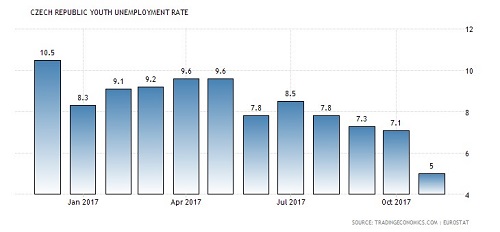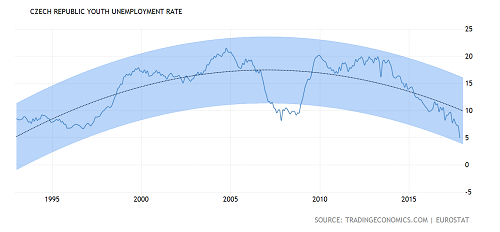
CR youth unemployment rate hits lowest levels since 1993
The youth unemployment rate is usually higher when compared to the unemployment rate of the other age groups. Photo: Pixabay
The European Union registered a youth unemployment rate of 18,2% in the end of 2017 while Germany, the country with the lowest rate in the whole Eurozone, registered a rate of 6.6 % in November 2017, according to the daily Observador.
Good news for the Czech Republic: last November, the country achieved the lowest youth unemployment rate in Europe (5.0%) and in the country’s history (since 1993). According to the Trading Economics.com, a company with over 10 years of experience in performing global economics research, this downward tendency will continue.

Czech Republic’s youth unemployment rate. Source: www.tradingeconomics.com
In the Czech Republic, the youth unemployment rate is expected to continue the downward trend at least until the end of the first quarter of 2018.
OECD defines youth unemployment rate as the number of people aged between 15 and 24 and without work, expressed in percentage of the youth labor force. This rate takes into account all young people, including those looking for a job, and full-time students who are neither working nor seeking for a job.
According to the Trading Economics Global Macro Models and analysts’ expectations, the youth unemployment rate in the Czech Republic will drop to 4.51% in the first quarter of 2018 and increase to maximum 5.18% in the last quarter of this year.
Last November, the youth unemployment rate declined from 7.10% (Oct 2017) to 5%. In the same period of 2016, the Czech Republic reported a 10.5% rate, whereas in the EU, it was 18.5%.
Specialists foresee that in 2020, the youth unemployment rate in the Czech Republic will reach 6.62% compared to 15.10% expected for the 28 EU. It is important to stress that the youth unemployment rate in the Czech Republic averaged at 14.11% between 1993 and 2017, reaching a peak of 21.50% in 2004.

Evolution trend the youth unemployment rate in the Czech Republic, from 1993 to 2017. Source: www.tradingeconomics.com
The Czech Republic has recently become the number one in the European rank and the predictions are favorable at least until 2020. Why?
Firstly, the country’s economic well-being is reflected in the decreasing overall unemployment rate (3.8 % in December 2017), and consequently, in the youth unemployment rate. Other factor that contributes for the Czech Republic to have the lowest youth unemployment rate in the EU is the overall hourly labor cost, CZK 258.03 much below the EU hourly paid average CZK 642.55.
Secondly, the higher the level of education, the better are the chances for young people to find a job in Czech Republic. According to the website Eurospondents, graduates find a job more easily than those who only finished mandatory education. This contradicts the current European trend – the more educated people are, the more they face unemployment due to a saturated market.
Seasonal and part-time jobs also explain the rate improvement between November and the end of the first quarter of 2018. “Czech employers in the pre-Xmas time focus a lot on temporary work”, wrote Lukáš Beňa from the recruiting agency, Monster.
At last, in 90’s, the Czech government created incentives that aimed to boost the economic growth and create more jobs. The incentives include tax breaks that attracted foreign investment and companies. The growth accelerated after the country joined the European Union.
Today, to keep up with the positive trend, “the government needs to change its decades-old incentives system to encourage the creation of high-skilled jobs, namely by improving the education system,” the chief economist at Deloitte in Prague, David Marek explained to QUARTZ.
Written by: Joana Dias

